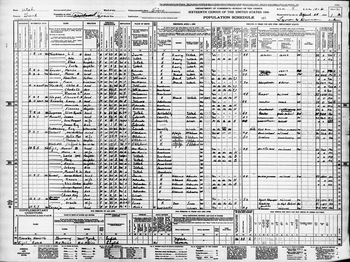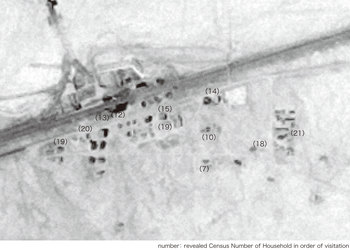Cisco at a Glance by the 16th Census [Column_Cisco Range]
 : first sheet of 1940 Census
: first sheet of 1940 CensusThe US Censuses are disclosed 72 years after they are taken. The 16th Census was released in 2012.
As for Cisco, it was enumerated by later county attorney Lyman Elvin Duncan (1913−1999) between April 28 and 30, 1940. It lists 248 persons in 49+1 dwellings, including temporal 109 persons in 12 dwellings of railroad section gang (+1 means a family is enumerated without the “number of Household in order of visitation”).
Northernmost of the Enumeration District (E.D. 10-6) at the foot of Book Mountains/Cliffs reside several rancher families.
Rancher Ole Leo Johnson (1905−1944), his wife, his two sons, and his three daughters reside in a rented home, rancher Clarence Edwin Greer (1902−1967), his wife, his four daughters, and his two sons reside in a rented home, rancher Byron Theodore Smith (1904−1989), his wife, and a lodger reside in a rented home, and rancher Albert James Turner (1886−1946), his three sons, and his daughter reside in his own home, all located at in the area.
Easternmost of the E.D. along the Colorado River and the Denver & Rio Grande Western Railroad locates the community of Westwater. Several rancher families and railroad worker families reside in the area.
Rancher Alton E. Tomlinson (1906−1969), his wife, and his son reside in his own home, mechanic Leland Edward Francis (1904−1969) and his wife reside in a rented home, sheepherder Emmett Elizondo (1897−1992), his wife, and his son reside in his own home, merchant John Coleman Hardison (1874−1943) and his wife Killy who was the postmistress of Westwater Post Office reside in a rented home, ranch-hand Bernard Etcheverry (1895−1962), his wife, his two daughters, and his son reside in a rented home, ranch-hand Jay Edmund Belding (1904
−1989), his wife, his three daughters reside in a rented home, and ranch manager Pierre Pete Etcheverry (1893−1979), his wife, his son, and two lodgers reside in a rented home, all located at along the river probably from the upstream to downstream in order.
Railroad section foreman Pedro Perez (1896−?) and his wife occupy the section house, section hand Benny Alered Titus (1906−1990), his wife, and his son reside in his own home, section hand Manuel R. Valenzuela (1913−?), his wife, and his son reside in a rented home, and section hand Leonard Salatino (1883−1957) resides in a rented home located at in the area.
Denver & Rio Grande Western Railroad was relocating and extending the Cottonwood siding located at the west of Westwater in 1940[1]. 109 persons in 12 dwellings − probably outfit sleepers − of railroad section gang enumerated in the Census seems to set out for the work.
At the east of Cisco townsite along the Colorado River aka Cisco Landing reside several rancher families and a pumper family.
Rancher Louis James Christensen (1898−1957), his wife, and his two daughters reside in a rented home, rancher Marion Frederick Gruver (1888−1947) resides in a rented home, rancher Mason A. Greer (1899−1980) and his father reside in a rented home, and a sheepherder, Chole A. Martin Hallett (1858−1940), and her two pumper sons reside in her own home, and rancher Emery Knowles (1870−1952), his wife, and his daughter reside in his own home, all located at along the river probably from the upstream to downstream in order.
At the west of Cisco townsite along the Denver & Rio Grande Western Railroad locates Whitehouse station. Section hand Monico Aguilera (1904−1978), his wife, his two daughters, and his two sons may occupy the bunkhouse, and section foreman Frank Chiodo (1909−1992), his wife, and his daughter may occupy the section house.
Within the Cisco townsite reside several workers and their families.
Easternmost of the townsite, gas service station proprietor William Boston Capansky (1887−1951), his wife, and his son reside in his own station/home(Census Number of Household in order of visitation 14). Sirano Puyales Garcia (1884−1957), maybe the operator of the Duke's Service at that time, resides in his own home(15) next to it.
The mail carrier Ralph Dalton (1916−2002), his wife, and his son reside in a rented house(17) later became owned by John Maynard. Post mistress Henrietta “Hattie” Marie Girard Fuller (1888−1966), and her two sons reside in the “Federal Building”(20) consisted of the Post Office and the dwelling.
Behind the Post Office, Virginia Frances Paxton Gruver (1898−1978) and her two sons reside in her own boarding house(19).
Along Second Street, several residents reside in rented dwellings.
Railroad section hand Manuel D. Vigil (1881−1951), his wife, his three daughters, and his two sons reside in a rented home(10) behind Capansky's home. Opposite the Vigil's home, Cisco School teacher Elsie B. Jorgensen (1918−?) resides in a rented home(7) owned by State road foreman Victor Kirby Murray (1893−1962). He also owns the later Ruth Cafe, Cisco mercantile, and several rental dwellings at that time.
Railroad section hand Newell Arthur Taylor (1911−1967), his wife, and his daughter reside in a rented home(18) to the east of Vigil’s. Victor himself seems to reside in a rented home by the State Road Maintenance Station(21) facing the townsite with his mother. Maintenance Station truck driver Abner Edward Greer (1904−1992), his wife, his daughter, and his three sons also reside in a rented home(24) by the Station.
Along the railroad tracks facing the townsite, several facilities are occupied by the railroad workers and their families.
Agent Jeremiah Patrick Brennan (1900−1996), and his wife occupy the depot(12), and section foreman George Richard Burwell (1903−1962), his wife, his daughter, and his three sons occupy the section house(11). Compressor-man James Anton Mussatt (1913−2008), his wife, his son, and his father–in–law, section hand Walter Nelson Devault (1902−1984), his wife, his daughter, and his brother-in-law, and section hand Lebrado “Lee” Carbajal (1912−2001), his wife, his daughter, his son, and a lodger who is also a section hand occupy each bunkhouse(8, 9, 13). Section hand Elias Armigo (1912−?) and his mother, and telegrapher Arline Chonita Church (1888−1973), reside in each rented home(16, 22) within the townsite.
Accordingly, 56 persons reside in 17 dwellings at Cisco. That brings 192 persons including 109 railroad section gang to scatter around in the surrounding wilderness.
The designation of the US Highway 6 in 1937 brought several roadside businesses to Cisco in the 30s: buses began to operate between Denver and Salt Lake City, garage became service station, and hotel became motel. However, contrarily, the abolition of the Prohibition in 1933 seems to have brought some kind of decay to the “red light district” of Cisco; pool hall became cafe.
For more, the former Cisco resident Vonna Lucinda Foy Dalton (1921−2016) describes her memories of Cisco in the 40s in the 2004 magazine Vol. 51 of Canyon Legacy. The 1944 USGS aerial photo also shows how downtown Cisco was in the early 40s.
[1] Jul. 3, 1940 Daily Sentinel;
 : 1944 USGS aerial photo
: 1944 USGS aerial photo2023-11-03 09:00
コメント(0)




コメント 0